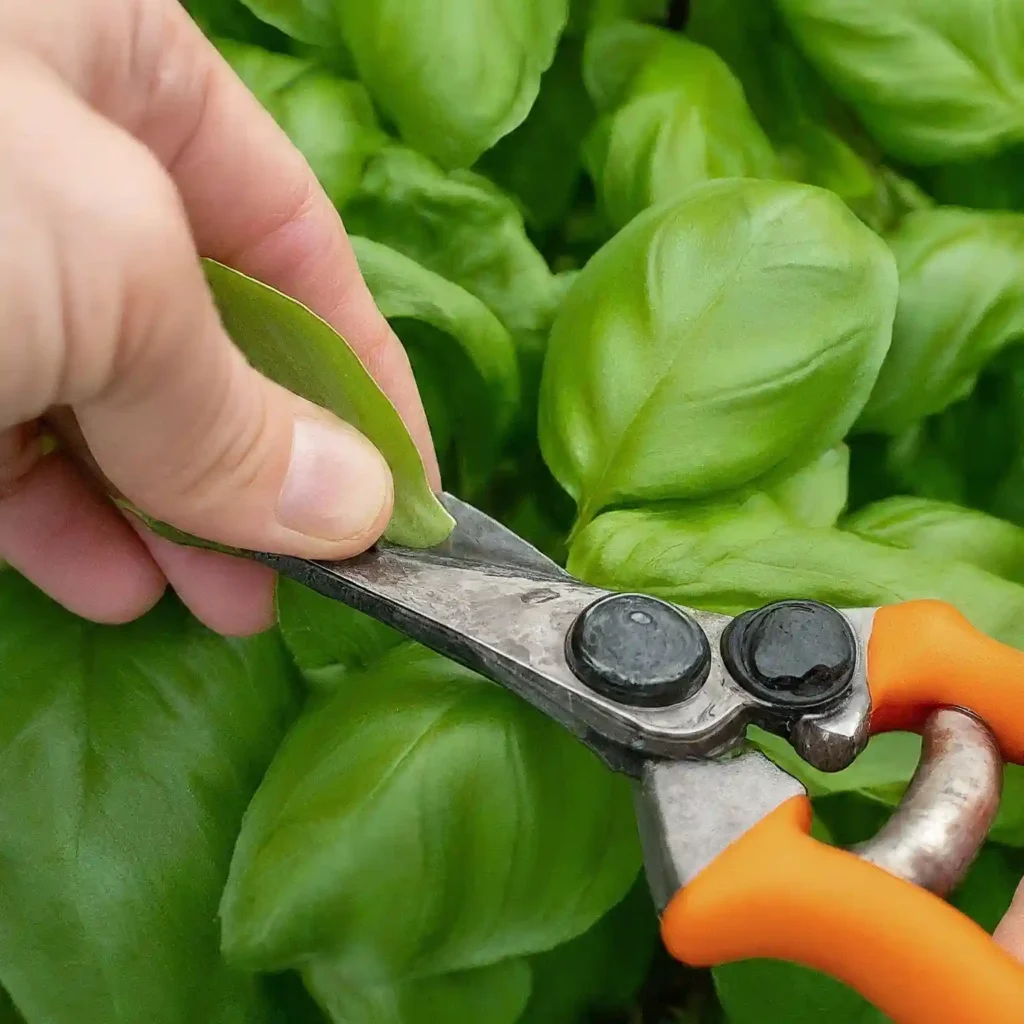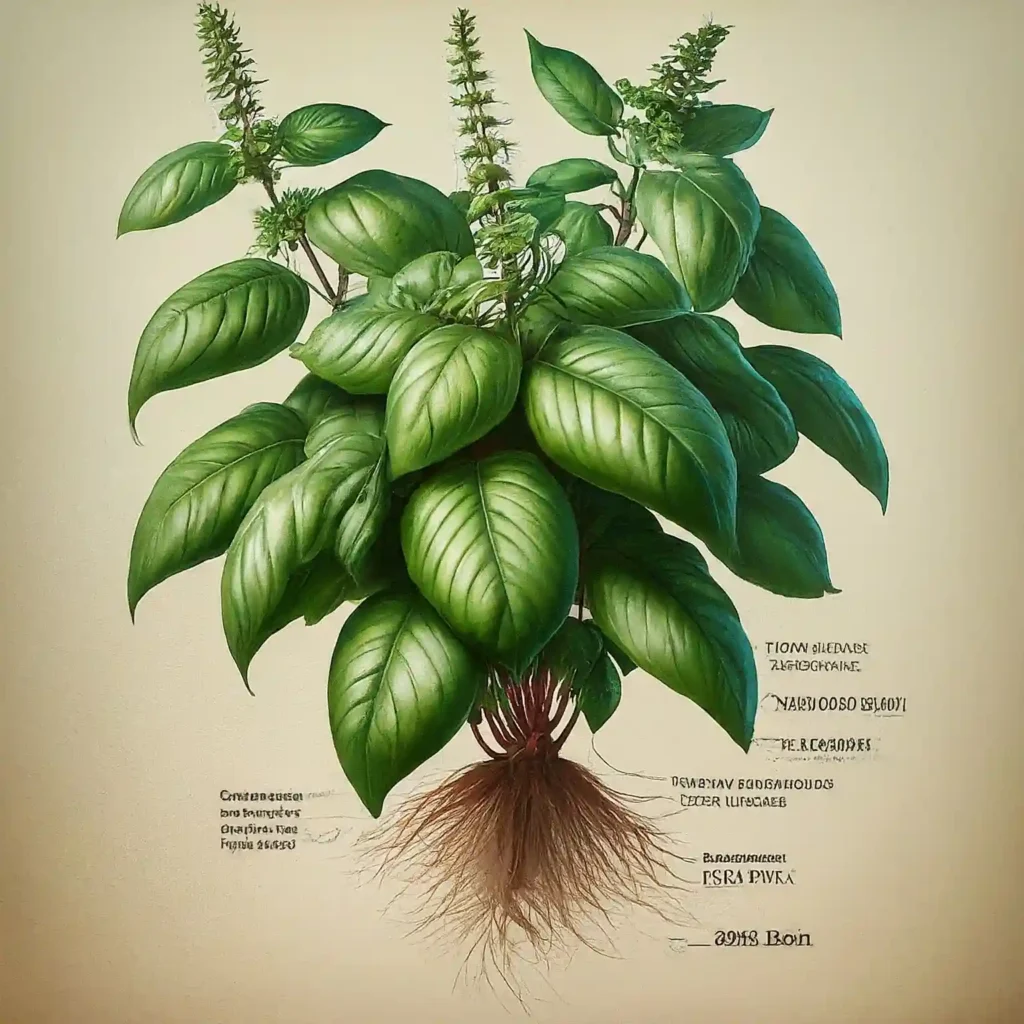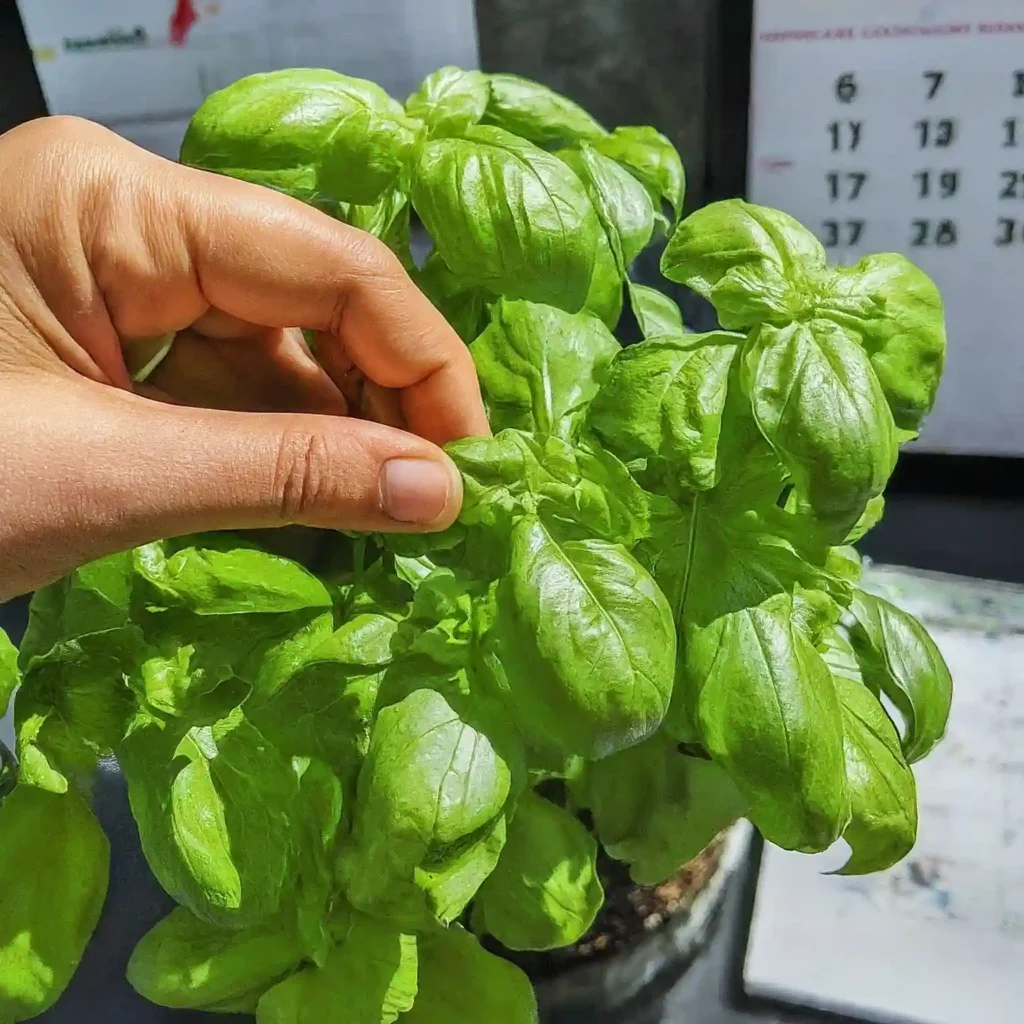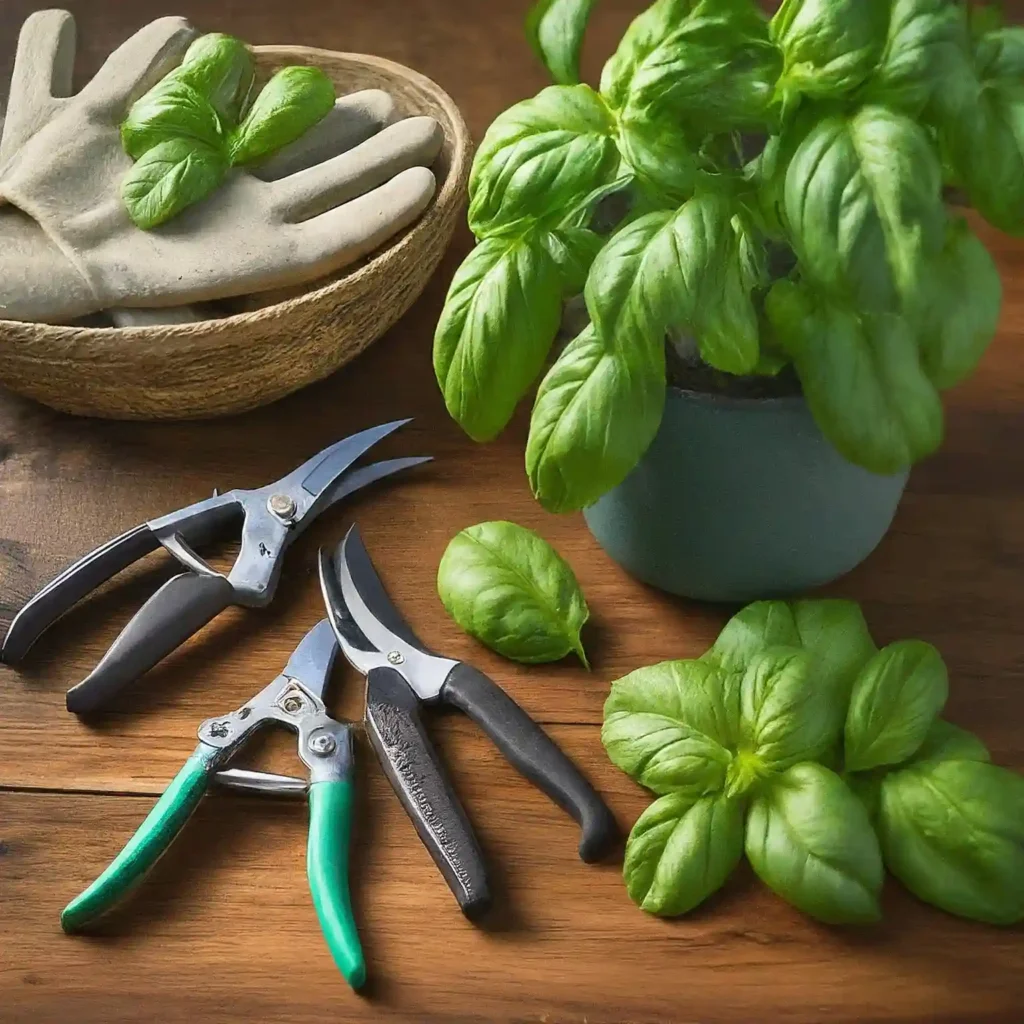
How to Prune Basil Plants for More Leaves
To encourage bushier growth and more leaves, prune basil plants regularly. Pinch off the growing tips of stems just above a set of leaves. This will force the plant to produce new shoots from below the cut, resulting in a fuller, more compact plant with more leaves for harvesting.
Understanding Basil Plant Growth
To effectively prune basil plants for more leaves, it’s essential to understand how these herbs grow and develop. Basil plants belong to the genus Ocimum and are known for their aromatic leaves, which are widely used in culinary dishes and herbal remedies.

Growth Patterns of Basil Plants
Basil plants typically have a bushy, branching growth habit, with leaves arranged in pairs along the stems. As the plant matures, it produces additional branches and sets of leaves, eventually forming a dense canopy of foliage.
The process of leaf development begins with the emergence of tiny leaf buds at the tips of the plant’s stems. These buds gradually unfurl into fully formed leaves, which continue to grow and expand over time.
During periods of active growth, basil plants may also produce clusters of small flowers at the tips of their stems. While these flowers can add visual interest to the plant, they can also signal a decrease in leaf production if left unchecked.
Research studies have shown that pruning basil plants can promote branching and encourage the growth of new leaves. By removing the apical meristem (the growing tip of the plant), pruning redirects the plant’s energy towards producing lateral branches and additional foliage.
Role of Pruning in Basil Plant Growth
Pruning is a fundamental technique in the cultivation of basil plants, crucial for shaping their growth and maximizing leaf production. By selectively removing unwanted foliage and flower buds, gardeners can exert control over the size, shape, and overall health of their basil plants.
Regular pruning has several benefits for basil plants. Firstly, it prevents them from becoming leggy or top-heavy, which can result in weak, spindly growth. By maintaining a compact, well-branched structure, gardeners can ensure that their basil plants remain sturdy and upright, reducing the risk of breakage or collapse.
Secondly, pruning stimulates the growth of new shoots and leaves. When a branch is pruned, the plant responds by redirecting its energy into the remaining branches, causing them to grow more vigorously. This results in a bushier, more productive basil plant with an abundance of flavorful leaves.
In addition to promoting leaf growth, pruning also enhances the overall health of basil plants. By removing overcrowded or diseased foliage, gardeners can improve air circulation around the plant, reducing the risk of fungal diseases and pest infestations. Proper pruning also allows sunlight to reach the lower parts of the plant, promoting even growth and preventing the development of weak or spindly stems.
Furthermore, pruning can be used to shape basil plants into desired forms, such as compact globes or upright pyramids. This not only adds aesthetic value to the garden but also helps to maximize space utilization, making it ideal for container gardening or small spaces.
Understanding the growth patterns of basil plants and the role of pruning in shaping their development is key to achieving optimal results in the garden. With proper care and attention, gardeners can enjoy a bountiful harvest of flavorful basil leaves throughout the growing season, enhancing their culinary creations and adding a touch of freshness and vitality to their gardens.
When to Prune Basil Plants
Pruning basil plants is a crucial aspect of maintaining their health and encouraging robust growth throughout the growing season. The ideal timing for pruning is when the plants are actively growing and have reached a certain size, typically about 4 to 6 weeks after planting.

Determining the Right Time to Prune:
- Size and Maturity: Look for plants that have grown to a height of 6 to 8 inches and have developed several sets of leaves. This indicates that the plant has established itself and is ready for pruning.
- Plant Health: Avoid pruning basil plants that are showing signs of stress, such as yellowing leaves or stunted growth. Wait until the plant recovers and regains vigor before pruning.
- Environmental Conditions: Consider environmental factors such as temperature and sunlight exposure. Avoid pruning during periods of extreme heat or drought, as the plant may already be under stress.
Pruning Frequency and Technique:
- Regular Pruning: During the peak growing season, aim to prune basil plants regularly, approximately once every 2 to 3 weeks. This helps maintain a compact shape and encourages continuous leaf production.
- Selective Pruning: Focus on removing only the necessary foliage. Use sharp, clean shears or scissors to make precise cuts just above a set of leaves.
- Avoid Over-Pruning: Over-pruning can stress the plant and inhibit growth. Leave enough leaves on the plant to support its energy needs.
Environmental Considerations:
- Avoid Pruning in Extreme Weather: Avoid pruning basil plants during periods of extreme heat or drought, as the plant may be more susceptible to damage. Wait for cooler temperatures and moist soil conditions.
- Dry Plants Before Pruning: Allow the basil plants to dry thoroughly before pruning to minimize the risk of infection or disease.
- Avoid Pruning After Watering: Wait until the plant has absorbed the water before pruning to prevent damaging the wet leaves.
Benefits of Timely Pruning:
- Improved Airflow and Light Penetration: Pruning helps to increase airflow and light penetration within the plant, promoting healthy growth and preventing diseases.
- Encourages Leaf Production: Regular pruning encourages the plant to produce new leaves, resulting in a bushier and more productive basil plant.
- Promotes Compact Growth: Pruning helps to maintain a compact and manageable size, making it ideal for container gardening or small spaces.
- Harvest High-Quality Leaves: Pruning regularly allows you to harvest high-quality, flavorful leaves throughout the growing season.
By following these guidelines and considering the right timing, environmental conditions, and pruning techniques, you can ensure that your basil plants thrive and provide you with a bountiful harvest of fresh, aromatic leaves.
Tools for Pruning Basil
Equipping yourself with the right tools is essential for effectively pruning basil plants and promoting abundant leaf growth. By using the proper tools and techniques, you can ensure clean, precise cuts that encourage healthy new growth while minimizing stress on the plant.

Sharp Scissors or Pruning Shears
One of the most important tools for pruning basil plants is a pair of sharp scissors or pruning shears. These tools allow you to make clean, precise cuts without causing unnecessary damage to the plant. Look for scissors or shears with sharp blades and comfortable handles that fit well in your hand.
When pruning basil plants, it’s essential to use sharp tools to avoid crushing or tearing the plant’s delicate stems and leaves. Dull or rusty blades can cause jagged cuts that leave the plant vulnerable to infection and disease. To maintain sharpness, regularly sharpen your scissors or pruning shears using a sharpening stone or file.
Gloves
While not strictly necessary, wearing gloves while pruning basil plants can help protect your hands from scratches and irritation. Choose gloves made from breathable, lightweight material that allows for dexterity and flexibility. This will make it easier to handle the plant and perform precise pruning tasks without discomfort.
Gloves can also provide an extra layer of protection against thorns, sharp edges, and potential allergens that may be present in the garden. By wearing gloves, you can prune your basil plants with confidence, knowing that your hands are protected from harm.
Other Considerations
In addition to scissors or pruning shears and gloves, you may also find it helpful to have a small pruning saw or loppers on hand for larger, woody stems. These tools can make quick work of thicker branches that may be difficult to cut with scissors alone.
When selecting pruning tools, choose high-quality options that are designed for gardening tasks. Avoid using household scissors or other improvised tools, as they may not provide the precision and durability needed for effective pruning.
By investing in the right tools and taking care to maintain them properly, you can ensure successful pruning sessions that promote healthy growth and abundant leaf production in your basil plants.
Additional Tips:
- Prune regularly: Regular pruning encourages new growth and keeps your basil plants healthy and productive.
- Prune in the morning: Pruning in the morning gives the cuts time to heal before the heat of the day.
- Avoid pruning in wet weather: Wet weather can spread diseases, so it’s best to prune when the plants are dry.
- Remove dead or diseased leaves: Dead or diseased leaves can harbor pests and diseases, so it’s important to remove them promptly.
- Use clean tools: Clean your pruning tools before and after each use to prevent the spread of diseases.
- Fertilize your basil plants: Fertilizing your basil plants regularly will help them grow healthy and strong.
Techniques for Pruning Basil
Mastering the art of pruning basil plants is crucial for maintaining their vigor, promoting bushier growth, and maximizing leaf production. By implementing the right techniques, you can transform your basil plants into flourishing specimens that yield an abundance of aromatic and flavorful leaves for culinary adventures. Here’s a comprehensive guide to pruning basil like a pro:
Pinching:
- Pinching is a gentle and effective pruning method that encourages branching and stimulates new growth.
- To pinch basil, use your thumb and forefinger to remove the top 1-2 inches of growth, just above a set of leaves or leaf nodes.
- Pinching removes the apical meristem, which is responsible for vertical growth, redirecting the plant’s energy towards lateral branching.
- Repeat the pinching process regularly throughout the growing season to maintain a compact, well-shaped plant with plenty of leaves.
Cutting:
- Cutting is a more intensive pruning technique that involves removing entire stems or branches from the basil plant.
- Use sharp scissors or pruning shears to make clean, angled cuts just above a set of leaves or leaf nodes.
- Cutting allows you to remove woody or leggy stems, as well as any flower buds that may have formed.
- By cutting back the plant, you encourage the development of new, more productive growth and redirect the plant’s energy towards leaf production.
Removing Flower Buds:
- As basil plants mature, they may produce small flower buds at the tips of their stems.
- While these flowers can be attractive, they signal a decline in leaf production if left unchecked.
- To prevent this, it’s essential to remove flower buds as soon as they appear.
- Pinching or snipping off flower buds with your fingers or pruning shears helps channel the plant’s energy back into leaf production, ensuring a continuous supply of fresh, flavorful leaves.
Additional Tips:
- Prune basil plants regularly, ideally in the morning to allow fresh cuts to heal during the day.
- Avoid pruning basil plants during hot or humid weather to minimize the risk of disease.
- Use clean and sharp tools to prevent damage to the plant and reduce the spread of diseases.
- Fertilize basil plants regularly to promote healthy growth and leaf production.
- Companion planting with other herbs and vegetables can help repel pests and diseases, reducing the need for excessive pruning.
By following these pruning techniques and incorporating them into your gardening routine, you can cultivate thriving basil plants that provide you with a bountiful harvest of aromatic and flavorful leaves throughout the growing season.
Common Mistakes to Avoid When Pruning Basil Plants
While pruning basil plants can greatly enhance their growth and leaf production, there are several common mistakes that gardeners often make. By being aware of these pitfalls and avoiding them, you can ensure that your basil plants remain healthy and productive. Here are some common mistakes to watch out for:
Over-Pruning
One of the most common mistakes gardeners make when pruning basil plants is over-pruning. While regular pruning is essential for promoting new growth and maintaining plant health, excessive pruning can stress the plant and inhibit its ability to produce leaves. Avoid the temptation to prune too aggressively, and instead focus on removing only the necessary foliage to encourage healthy growth.
Pruning at the Wrong Time
Timing is crucial when it comes to pruning basil plants. Pruning too early in the plant’s growth cycle can stunt its development and reduce overall yield, while pruning too late can result in woody, unproductive stems. Be sure to wait until the plant has established itself and is actively growing before initiating any pruning activities.
Improper Pruning Technique
Using the wrong pruning technique can also lead to problems with basil plants. For example, making jagged or uneven cuts can leave the plant vulnerable to infection and disease. Always use sharp, clean pruning tools and make smooth, angled cuts just above a set of leaves or leaf nodes to promote healthy growth.
Ignoring Pest and Disease Issues
Pest and disease problems can quickly take a toll on basil plants if left unchecked. While pruning can help remove affected foliage and reduce the spread of pests and diseases, it’s important to address underlying issues such as poor soil drainage or overcrowding. Monitor your basil plants regularly for signs of pests and diseases, and take prompt action to address any problems that arise.
Not Providing Adequate Care
Finally, neglecting to provide proper care and attention to your basil plants can also hinder their growth and leaf production. Be sure to water, fertilize, and provide appropriate growing conditions for your plants to thrive. By giving your basil plants the care they need, you can help ensure a bountiful harvest of fresh, flavorful leaves.
By avoiding these common mistakes and following proper pruning techniques, you can enjoy healthy, productive basil plants that provide you with a steady supply of delicious leaves all season long.
Troubleshooting Basil Plant Issues
While basil plants are generally easy to grow, they can sometimes encounter problems that affect their growth and leaf production. By learning to recognize and address these issues promptly, you can help ensure that your basil plants remain healthy and productive. Here are some common problems you may encounter when growing basil, along with solutions to help you troubleshoot them:
Pest Infestations
Basil plants are susceptible to a variety of pests, including aphids, whiteflies, and spider mites, which can damage leaves and stunt growth if left unchecked. To control pest infestations, inspect your basil plants regularly and remove any affected foliage. You can also use insecticidal soap or neem oil to treat pest infestations, following label instructions carefully.
Diseases
Basil plants can also be affected by fungal diseases such as fusarium wilt, downy mildew, and basil leaf spot, which can cause leaves to wilt, yellow, or develop spots. To prevent fungal diseases, avoid overhead watering and provide good air circulation around the plants. If disease problems persist, remove and dispose of affected plants to prevent further spread.
Nutrient Deficiencies
Inadequate nutrient levels in the soil can also impact basil plant growth and leaf production. Common nutrient deficiencies in basil plants include nitrogen, phosphorus, and potassium. To address nutrient deficiencies, fertilize your basil plants regularly with a balanced fertilizer and amend the soil with organic matter as needed.
Environmental Stress
Environmental factors such as extreme heat, drought, or cold temperatures can stress basil plants and inhibit their growth. To minimize environmental stress, provide consistent moisture, shade plants during hot afternoons, and protect them from frost in colder climates. Mulching around the base of the plants can also help regulate soil temperature and moisture levels.
Overcrowding
Overcrowding can also be a problem for basil plants, as it can restrict airflow and lead to increased humidity, which can promote the development of fungal diseases. To prevent overcrowding, space basil plants at least 6 to 8 inches apart in the garden, or thin seedlings to allow for proper airflow and light penetration.
By addressing these common issues and providing proper care and attention to your basil plants, you can help ensure that they remain healthy and productive throughout the growing season.
Advanced Pruning Tips for Experienced Gardeners
For seasoned gardeners looking to take their basil plant pruning skills to the next level, there are several advanced techniques and strategies you can employ to optimize growth and leaf production. These techniques require a bit more finesse and experience but can yield impressive results when implemented correctly. Here are some advanced pruning tips to consider:
Selective Pruning
Selective pruning involves carefully choosing which stems or branches to remove from the basil plant based on their size, position, and overall health. Instead of simply removing excess growth, selectively prune the plant to encourage specific branches or stems to grow and develop. This can help shape the plant more precisely and promote a more balanced, aesthetically pleasing appearance.
Training Techniques
Training techniques such as topping and pinching can help shape the growth of basil plants and encourage bushier, more compact growth. Topping involves removing the top portion of the main stem to promote branching and lateral growth, while pinching involves removing the tips of individual stems to encourage branching and stimulate new growth. By incorporating these techniques into your pruning routine, you can create denser, more productive basil plants.
Companion Planting
Companion planting involves growing basil alongside other plants that complement its growth habits and provide mutual benefits. For example, planting basil alongside tomatoes, peppers, or oregano can help deter pests and improve overall plant health. Additionally, certain companion plants may help attract beneficial insects or improve soil fertility, further enhancing the growth and productivity of your basil plants.
Regular Maintenance
Regular maintenance is essential for keeping basil plants healthy and productive over the long term. This includes monitoring for pest and disease problems, providing adequate water and nutrients, and pruning as needed to maintain shape and encourage new growth. By staying proactive and attentive to your basil plants’ needs, you can help ensure they remain vibrant and productive throughout the growing season.
Experimentation
Don’t be afraid to experiment with different pruning techniques and strategies to see what works best for your basil plants and growing conditions. Every garden is unique, and what works well for one gardener may not necessarily work for another. By staying open-minded and willing to try new approaches, you can continue to refine your pruning skills and achieve even better results in the garden.
By incorporating these advanced pruning tips into your gardening routine, you can take your basil plant cultivation to new heights and enjoy even greater success in growing healthy, productive plants.
Conclusion: Mastering the Art of Pruning Basil Plants
Congratulations! You’ve now learned the ins and outs of how to prune basil plants for more leaves, from basic techniques to advanced strategies. By incorporating these tips into your gardening routine, you can ensure healthy, productive basil plants that provide you with a steady supply of fresh, flavorful leaves throughout the growing season.
Recap of Key Points
Throughout this guide, we’ve covered a variety of important topics related to pruning basil plants. We’ve discussed the importance of pruning for promoting healthy growth and maximizing leaf production, as well as the best times to prune and the essential tools and techniques to use. We’ve also touched on common mistakes to avoid, troubleshooting tips for addressing common issues, and advanced strategies for experienced gardeners.
Take Action
Now that you have the knowledge and skills to prune basil plants effectively, it’s time to put them into action. Head out to your garden, armed with your pruning shears and newfound expertise, and start shaping your basil plants into lush, productive specimens. Remember to approach pruning with care and precision, taking into account the unique needs of each plant and adjusting your techniques accordingly.
Continued Learning
Gardening is a lifelong journey of learning and discovery, and there’s always more to explore. Continue to educate yourself on the latest techniques and trends in gardening, experiment with new varieties and pruning methods, and don’t be afraid to ask for advice or seek out additional resources when needed.
Stay Connected
Finally, remember that you’re not alone on your gardening journey. There’s a vast community of fellow gardeners out there who are eager to share their knowledge and experiences. Consider joining a gardening club or online forum, attending workshops or seminars, or simply connecting with other gardeners in your area to exchange tips, swap stories, and celebrate your successes together.
FAQs about Pruning Basil Plants for More Leaves
Q: When is the best time to prune basil plants?
A: The best time to prune basil plants is when they have reached a height of 6 to 8 inches and have developed several sets of leaves, typically about 4 to 6 weeks after planting. Prune regularly every 2 to 3 weeks during the growing season for optimal results.
Q: What tools do I need to prune basil plants?
A: Essential tools for pruning basil plants include sharp scissors or pruning shears and gloves. Sharp tools ensure clean cuts without damaging the plant, while gloves protect your hands from scratches and irritation.
Q: How often should I prune basil plants?
A: It’s recommended to prune basil plants regularly, about once every 2 to 3 weeks during the growing season. This helps maintain a compact shape, stimulate new growth, and maximize leaf production.
Q: Can pruning basil plants increase leaf production?
A: Yes, pruning basil plants can increase leaf production by redirecting the plant’s energy towards producing more leaves. Removing excess foliage and encouraging branching results in a bushier, more attractive plant with enhanced flavor and aroma.
Q: What are some common mistakes to avoid when pruning basil plants?
A: Common mistakes to avoid when pruning basil plants include over-pruning, pruning at the wrong time, using improper pruning techniques, ignoring pest and disease issues, and not providing adequate care. These mistakes can hinder plant growth and leaf production if left unchecked.
Q: Are there advanced techniques for pruning basil plants?
A: Yes, there are advanced techniques for pruning basil plants, such as selective pruning, training techniques like topping and pinching, companion planting, and regular maintenance. These techniques can help shape plant growth, encourage bushier growth, and optimize leaf production.
Q: How can I troubleshoot common issues with basil plants related to pruning?
A: Common issues with basil plants related to pruning include pest infestations, diseases, nutrient deficiencies, environmental stress, and overcrowding. To troubleshoot these issues, regularly inspect your plants for signs of problems, address underlying issues, and provide proper care and attention.
Q: Where can I find more information on pruning basil plants?
A: For more information on pruning basil plants and maximizing leaf production, consult reputable gardening resources such as gardening websites, university extension websites, gardening books and guides, local garden centers and nurseries, online gardening forums, and online gardening courses. These resources offer valuable insights and advice to help you become a successful basil gardener.
